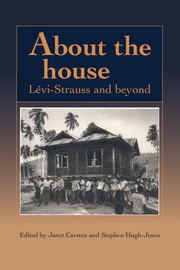Book contents
- Frontmatter
- Contents
- List of illustrations
- List of contributors
- 1 Introduction
- 2 Houses and hierarchies in island Southeast Asia
- 3 The resurrection of the house amongst the Zafimaniry of Madagascar
- 4 The hearth-group, the conjugal couple and the symbolism of the rice meal among the Kelabit of Sarawak
- 5 Houses in Langkawi: stable structures or mobile homes?
- 6 Having your house and eating it: houses and siblings in Ara, South Sulawesi
- 7 The Lio House: building, category, idea, value
- 8 Houses and hierarchy: the view from a South Moluccan society
- 9 Houses, places and people: community and continuity in Guiana
- 10 The houses of the Mẽbengokre (Kayapó) of Central Brazil – a new door to their social organization
- 11 Inside-out and back-to-front: the androgynous house in Northwest Amazonia
- Notes
- Bibliography
- Index
1 - Introduction
Published online by Cambridge University Press: 05 June 2012
- Frontmatter
- Contents
- List of illustrations
- List of contributors
- 1 Introduction
- 2 Houses and hierarchies in island Southeast Asia
- 3 The resurrection of the house amongst the Zafimaniry of Madagascar
- 4 The hearth-group, the conjugal couple and the symbolism of the rice meal among the Kelabit of Sarawak
- 5 Houses in Langkawi: stable structures or mobile homes?
- 6 Having your house and eating it: houses and siblings in Ara, South Sulawesi
- 7 The Lio House: building, category, idea, value
- 8 Houses and hierarchy: the view from a South Moluccan society
- 9 Houses, places and people: community and continuity in Guiana
- 10 The houses of the Mẽbengokre (Kayapó) of Central Brazil – a new door to their social organization
- 11 Inside-out and back-to-front: the androgynous house in Northwest Amazonia
- Notes
- Bibliography
- Index
Summary
House images move in two directions: they are in us as much as we are in them.
(Gaston Bachelard 1964: xxxiii)The essays in this collection are concerned with houses, but not simply with houses as physical structures. They focus instead on the interrelations between buildings, people and ideas, using ethnographic case studies to reveal some of the different ways in which houses come to stand for social groups and represent the world around them. Places in which the to and fro of life unfolds, built, modified, moved or abandoned in accord with the changing circumstances of their inhabitants, houses have dynamic, processual characteristics encapsulated in the word ‘dwelling’. These characteristics, shared by buildings and the groups and categories they represent, are also reflected in the chapters that follow.
Inspired by Lévi-Strauss's writings on ‘house societies’ and based on a workshop held in Cambridge in the spring of 1990, our book has two interconnected aims. We take a sympathetic but critical look at Lévi-Strauss's ideas of the house as a specific form of social organization, testing its utility against empirical cases drawn from Southeast Asia and lowland South America. Forms of social organization in these two areas show both striking parallels and marked contrasts and each has a key role in Lévi-Strauss's studies of kinship, South America representing the earliest phase and Southeast Asia the most recent.
- Type
- Chapter
- Information
- About the HouseLévi-Strauss and Beyond, pp. 1 - 46Publisher: Cambridge University PressPrint publication year: 1995
- 87
- Cited by



